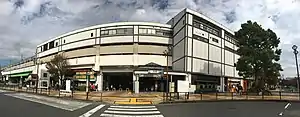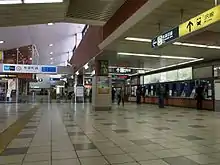Shin-Kiba Station
Shin-Kiba Station (新木場駅, Shin-kiba-eki) is a railway station in Kōtō, Tokyo, Japan, operated jointly by Tokyo Metro, East Japan Railway Company (JR East), and Tokyo Waterfront Area Rapid Transit (TWR).
JE05 Y24 R01 Shin-Kiba Station 新木場駅 | ||||||||||||||||||||||||||||||||||||||||||||
|---|---|---|---|---|---|---|---|---|---|---|---|---|---|---|---|---|---|---|---|---|---|---|---|---|---|---|---|---|---|---|---|---|---|---|---|---|---|---|---|---|---|---|---|---|
 In front of the station, 2020 | ||||||||||||||||||||||||||||||||||||||||||||
| Location | Kōtō-ku, Tokyo Japan | |||||||||||||||||||||||||||||||||||||||||||
| Coordinates | 35°38′45″N 139°49′37″E | |||||||||||||||||||||||||||||||||||||||||||
| Operated by | ||||||||||||||||||||||||||||||||||||||||||||
| Line(s) |
| |||||||||||||||||||||||||||||||||||||||||||
| Other information | ||||||||||||||||||||||||||||||||||||||||||||
| Station code | Y-24 | |||||||||||||||||||||||||||||||||||||||||||
| History | ||||||||||||||||||||||||||||||||||||||||||||
| Opened | 8 June 1988 | |||||||||||||||||||||||||||||||||||||||||||
| Services | ||||||||||||||||||||||||||||||||||||||||||||
| ||||||||||||||||||||||||||||||||||||||||||||
| Location | ||||||||||||||||||||||||||||||||||||||||||||
 Shin-Kiba Station Location within Tokyo  Shin-Kiba Station Shin-Kiba Station (Japan) | ||||||||||||||||||||||||||||||||||||||||||||
Lines
Shin-Kiba Station is served by the following lines:
- Y Tokyo Metro Yūrakuchō Line (Station number Y-24)
- JE Keiyo Line (JR East)
- R Rinkai Line (TWR)

Station layout
Each of the three lines has its own station facilities.
JR East platforms
The JR East station consists of a single island platform serving two tracks.
| 1 | JE Keiyō Line | for Maihama, Kaihimmakuhari, Soga, Kazusa-Ichinomiya, and Kimitsu |
| JM Musashino Line through service | for Nishi-Funabashi and Shim-Matsudo | |
| 2 | JE Keiyō Line | for Tokyo |
 JR East ticket gates
JR East ticket gates JR East platform
JR East platform
Tokyo Metro platforms
| 1 | Y Tokyo Metro Yurakucho Line | Arrival only |
| 2 | Y Tokyo Metro Yurakucho Line | for Yūrakuchō, Iidabashi, Ikebukuro, Kotake-Mukaihara and Wakōshi TJ Tobu Tojo Line for Shinrinkōen |
 Tokyo Metro platforms
Tokyo Metro platforms
TWR platforms
| 1, 2 | R TWR Rinkai Line | for Tokyo Teleport, Ōimachi and Ōsaki JA Saikyō Line for Shibuya, Shinjuku and Ōmiya ■ Kawagoe Line for Kawagoe |
 Ticket gates
Ticket gates Platform
Platform
History
The Teito Rapid Transit Authority (now Tokyo Metro) station opened on 8 June 1988, as the southern terminus of the Yūrakuchō Line.[1]
On 1 December 1988, JR East opened its Shin-Kiba Station platforms as the western terminus of the Keiyō Line. The Keiyō Line was extended from Shin-Kiba Station to Tokyo Station from 10 March 1990.
The TWR station opened on 30 March 1996, as the eastern terminus of the Rinkai Line.[1] From 1 December 2002, JR Saikyō Line trains were extended to operate over the Rinkai Line to Shin-Kiba Station.
Passenger statistics
In fiscal 2013, the JR East station was used by an average of 70,831 passengers daily (boarding passengers only), making it the 61st-busiest station operated by JR East.[2] In fiscal 2013, the Tokyo Metro station was used by an average of 101,043 passengers per day (exiting and entering passengers), making it the 34th-busiest station operated by Tokyo Metro.[3] In fiscal 2013, the TWR station was used by an average of 30,312 people daily (boarding passengers only).[4] The average daily passenger figures for each operator in previous years are as shown below.
| Fiscal year | JR East | Tokyo Metro | TWR |
|---|---|---|---|
| 2000 | 41,550[5] | ||
| 2005 | 55,653[6] | ||
| 2010 | 65,780[7] | ||
| 2011 | 64,487[8] | 93,783[9] | 25,887[4] |
| 2012 | 67,590[10] | 96,852[11] | 29,026[4] |
| 2013 | 70,831[2] | 101,043[3] | 30,312[4] |
- Note that JR East and TWR figures are for boarding passengers only.
Surrounding area
- Tokyo Gate Bridge (within walking distance)
- Yumenoshima Park
- Yumenoshima Tropical Greenhouse Dome
- AgeHa nightclub and event space
- Tokyo Metro Shinkiba Depot
- Tokyo Heliport
See also
References
- Terada, Hirokazu (July 2002). データブック日本の私鉄 [Databook: Japan's Private Railways]. Japan: Neko Publishing. p. 196/214. ISBN 4-87366-874-3.
- 各駅の乗車人員 (2013年度) [Station passenger figures (Fiscal 2013)] (in Japanese). Japan: East Japan Railway Company. Retrieved 25 September 2014.
- 各駅の乗降人員ランキング [Station usage ranking] (in Japanese). Tokyo Metro. Retrieved 25 September 2014.
- りんかい線について [Rinkai Line FAQ] (in Japanese). Japan: Tokyo Waterfront Area Rapid Transit Inc. Archived from the original on 12 November 2014. Retrieved 25 September 2014.
- 各駅の乗車人員 (2000年度) [Station passenger figures (Fiscal 2000)] (in Japanese). Japan: East Japan Railway Company. Retrieved 2 September 2014.
- 各駅の乗車人員 (2005年度) [Station passenger figures (Fiscal 2005)] (in Japanese). Japan: East Japan Railway Company. Retrieved 25 September 2014.
- 各駅の乗車人員 (2010年度) [Station passenger figures (Fiscal 2010)] (in Japanese). Japan: East Japan Railway Company. Retrieved 25 September 2014.
- 各駅の乗車人員 (2011年度) [Station passenger figures (Fiscal 2011)] (in Japanese). Japan: East Japan Railway Company. Retrieved 25 September 2014.
- 駅別乗降人員順位表(2011年度1日平均) [Station passenger figures (Fiscal 2011)] (in Japanese). Japan: Tokyo Metro. Retrieved 25 September 2014.
- 各駅の乗車人員 (2012年度) [Station passenger figures (Fiscal 2012)] (in Japanese). Japan: East Japan Railway Company. Retrieved 25 September 2014.
- 各駅の乗降人員ランキング (2012年) [Station usage ranking (2012)] (in Japanese). Tokyo Metro. Retrieved 25 September 2014.
External links
| Wikimedia Commons has media related to Shin-Kiba Station. |
- Tokyo Metro station information (in Japanese)
- JR East station information (in Japanese)
- TWR station information (in Japanese)
